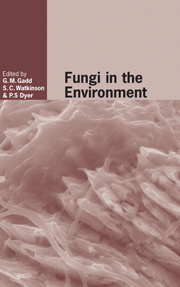Book contents
- Frontmatter
- Contents
- List of contributors
- Preface
- I Imaging and modelling of fungi in the environment
- II Functional ecology of saprotrophic fungi
- 5 Mineral transformations and biogeochemical cycles: a geomycological perspective
- 6 Mycelial responses in heterogeneous environments: parallels with macroorganisms
- 7 Natural abundance of 15N and 13C in saprotrophic fungi: what can they tell us?
- III Mutualistic interactions in the environment
- IV Pathogenic interactions in the environment
- V Environmental population genetics of fungi
- VI Molecular ecology of fungi in the environment
- Index
- References
5 - Mineral transformations and biogeochemical cycles: a geomycological perspective
from II - Functional ecology of saprotrophic fungi
Published online by Cambridge University Press: 03 November 2009
- Frontmatter
- Contents
- List of contributors
- Preface
- I Imaging and modelling of fungi in the environment
- II Functional ecology of saprotrophic fungi
- 5 Mineral transformations and biogeochemical cycles: a geomycological perspective
- 6 Mycelial responses in heterogeneous environments: parallels with macroorganisms
- 7 Natural abundance of 15N and 13C in saprotrophic fungi: what can they tell us?
- III Mutualistic interactions in the environment
- IV Pathogenic interactions in the environment
- V Environmental population genetics of fungi
- VI Molecular ecology of fungi in the environment
- Index
- References
Summary
Introduction
Rocks and minerals represent a vast reservoir of elements, many of them are essential to life. Bulk biological metals, such as Na, K, Mg and Ca, are among the eight most abundant elements in the Earth's crust and together make up 11.06% of crustal rock (Fraústo da Silva & Williams, 1993; Gadd, 2004). Rocks and minerals also include essential metals (e.g. Mn, Mo, Fe, Co, Ni, Cu, Zn) and, crucial for microbial and plant growth, phosphorus. Many elements have essential functional potential for the synthesis of biological macromolecules and energy capture (e.g. C, N, H, O, P, S), for the transmission of information (e.g. Na, K, Ca), for catalysis (e.g. Fe, Cu, Zn, Mo), for transfer of electrons (e.g. Fe), and for building solid structures (e.g. Ca, P, Si) (Fraústo da Silva & Williams, 1993). All these elements must be released into bioavailable forms that can be assimilated by the biota. Their release occurs via weathering of rock substrates and their mineral constituents through physical (mechanical), chemical and biological processes (Burford et al., 2003). Near-surface weathering of rocks and minerals (sub-aerial and sub-soil environments) often involves an interaction between all three types (White et al., 1992). In addition to mobilization of essential nutrients during lithospheric weathering, non-essential toxic metals (e.g. Cs, Al, Cd, Hg, Pb) may also be mobilized (Gadd, 1993, 2001a, b).
- Type
- Chapter
- Information
- Fungi in the Environment , pp. 77 - 111Publisher: Cambridge University PressPrint publication year: 2007
References
- 8
- Cited by



